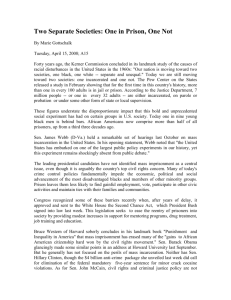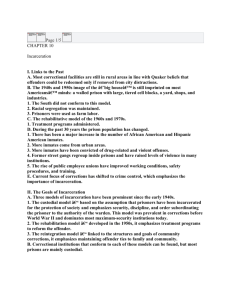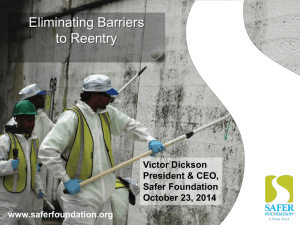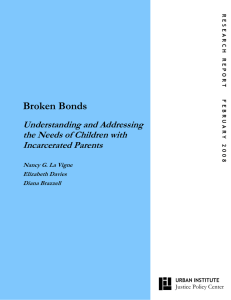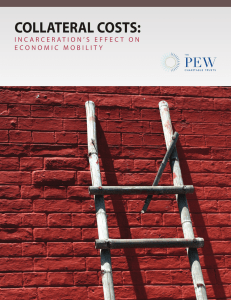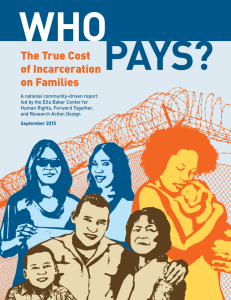Full Report as a Word Document
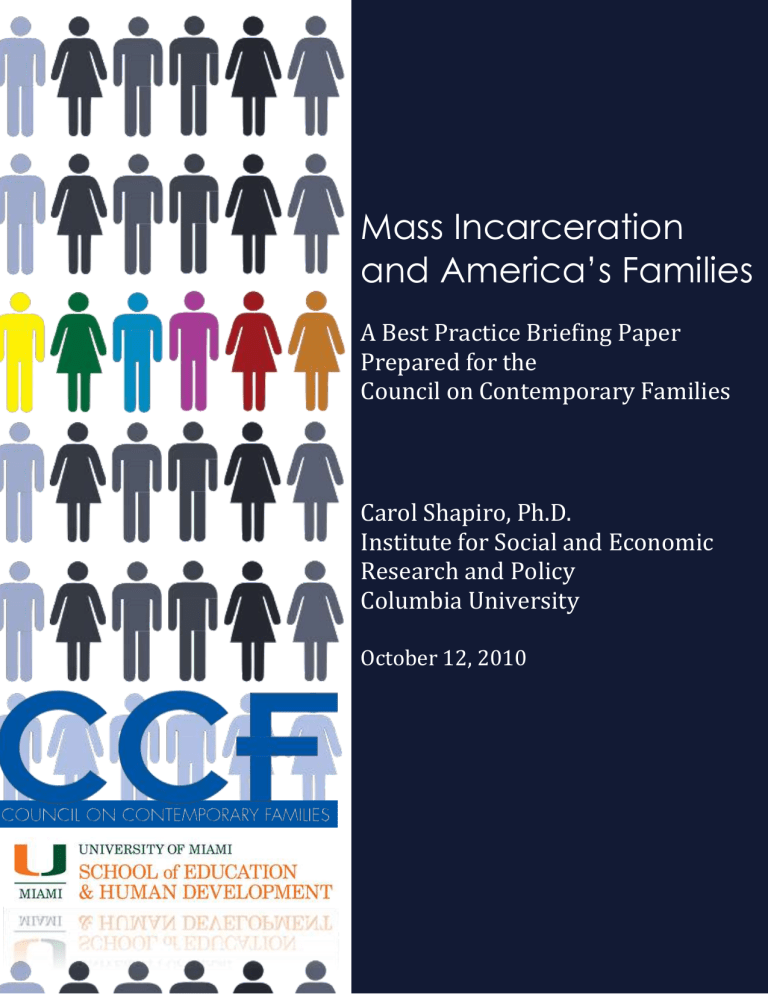
Mass Incarceration and America’s Families
A Best Practice Briefing Paper
Prepared for the
Council on Contemporary Families
Carol Shapiro, Ph.D.
Institute for Social and Economic
Research and Policy
Columbia University
October 12, 2010
MASS INCARCERATION SHAPIRO 2
Mass Incarceration and America’s Families
Carol Shapiro, Ph.D.
Institute for Social and Economic Research and Policy
Columbia University
October 16 is the 37 th anniversary of congressional approval of the Drug Enforcement
Administration, whose purpose, in the words of then-President Richard Nixon, was to coordinate an "all-out war" on drugs. Before the 1970's, drug abuse had been seen by policy makers primarily as a disease that could be addressed by treatment. During the
1970s, however, drug abuse - even in the absence of any violent or other criminal behavior
- came to be seen as a law enforcement problem to be solved through aggressive arrest and incarceration policies.
Since then, the United States has increased its rates of imprisonment by nearly 500 percent.
We now incarcerate a far higher proportion of our citizens than any other nation -- 2.3 million adults and an additional eight hundred thousand youths. This is a higher proportion than in either China or Russia, and higher than the top 35 European countries combined, per recent reports. As an absolute number it represents more than the combined populations of Boston, San Francisco, and Washington, DC.
On any given day, at least one in 100 adults is in our nation's jails and prisons, while more than one in 30 adults is under some form of correctional custody, including probation and parole supervision in the community. More than half of all inmates are parents of minor children. Almost 3 million minor children have a parent behind bars-that is one in 28--and about one million juveniles are themselves under some form of correctional supervision, creating complex relationships between parents, schools, probation officers, and other agencies.
Low-income communities are disproportionately affected by America's mass incarceration practices. Residents are more likely to be arrested, prosecuted, and sent to jail for the same offenses that lead to warnings, probation, or treatment programs in more affluent neighborhoods. Most convictions in low-income communities, contrary to popular impression, are for nonviolent acts, with drug users and the mentally ill heavily overrepresented in the prison population. Two-thirds of incarcerated parents of minor children are in jail for non-violent acts. Many non-violent offenders cycle in and out of jail simply because of technical violations of probation or parole rules, not because they have committed new crimes.
WHY SHOULD WE CARE?
Mass incarceration is not just a problem for the individuals involved. It weakens families and communities. Before they were incarcerated, more than half of all male inmates were the primary financial support for their children. High rates of imprisonment deprive wives, partners, and children of economic support even after an inmate is released. Job seekers
MASS INCARCERATION SHAPIRO 3 with a criminal record are only half as likely to be hired as other men; if they are African-
American, they get two-thirds fewer job offers. Even when they find work, incarceration decreases men's earnings by up to 40 percent for years after release.
Parental imprisonment has been shown to worsen children's behavioral and psychological problems, as well as to exacerbate other family tensions, with the largest negative effects showing up in the families of non-violent offenders. Controlling for other variables, researchers find that sons of incarcerated fathers engage in more aggression than comparable boys. Children whose fathers have been jailed are almost 6 times more likely to be expelled or suspended than other children.
In low-income communities where extended family systems are crucial for survival but one or more family members are enmeshed in the criminal and juvenile justice systems, families often interact with multiple governmental agencies -- child protection, public housing, welfare, and truancy officers. But each organization concentrates only on the individual, failing to take account of the constraints facing the family unit as a whole. One agency may be concerned with a child's truancy and not realize why the mother is absent, working two jobs, while dad is in jail. A physician treating one family member may not recognize the symptoms of stress due to chronic stress and family separation. Family members other than the offender are often punished -- with loss of child custody, loss of financial benefits, eviction, or reduced jail visitation rights -- for one person's noncompliance with mandated conditions of release or probation.
Finally, mass incarceration is expensive. At 80 dollars per day, it costs more to keep a person in prison for a year than to finance a year's tuition at most colleges. Recent estimates suggest that a reduction by just one-half of the incarceration of non-violent offenders would save local and state governments as much as 16.9 billion dollars per year.
And according to a study by the Center for Economic and Policy Research, such a reduction would not reduce public safety.
WHAT CAN BE DONE?
To help incarcerated and previously incarcerated individuals and their families break the cycle of repeated involvement with the penal system, we need a more holistic, wraparound approach that puts the family, rather than the individual, at the center of rehabilitation and reintegration programs. Several demonstration projects around the country have shown the benefits of shifting the emphasis in our current social services and correctional institutions to focus on the entire family rather than on individual offenders.
Such an approach allows service providers to address the special needs of individuals who have family members incarcerated, resulting in more effective work with these clients while also helping them maintain their ties with the incarcerated or supervised family members.
In turn, helping the family stay connected helps incarcerated individuals reintegrate into the community after release. Prisoners who receive at least one visit during their incarceration are three times more likely to have housing upon release, and are more than
MASS INCARCERATION SHAPIRO 4 twice as likely to be employed or to benefit from training or educational placement.
Coordinated services that take account of the special circumstances in families with members involved in the justice system can be effective in reducing truancy and family violence and ensuring stable household income and housing.
SUCCESSFUL DEMONSTRATION PROJECTS
La Bodega de la Familia, a demonstration project of the Vera Institute of Justice from 1996-
2000, pioneered a partnership between law enforcement, families and their communities.
By involving and supporting families with a loved one under parole supervision, La Bodega achieved a 60 percent decrease in drug use among study participants in six months. Health care was improved for 90 percent of family members, and 80 percent of families reported an increase in overall family well-being.
Building on these successes, Family Justice was founded in 2000 to set up national strength-based, family-focused intervention programs for adult and juvenile correction systems. Working in partnership with prisons, jails, probation and paroling authorities,
Family Justice developed programs to involve families, staff within the criminal and juvenile justice systems, and participants incarcerated or under community supervision due to a criminal allegation or conviction.
A SOCIAL TIES APPROACH
With support from the Justice Department, for example, Family Justice partnered with the prison systems of Oklahoma, Ohio, Massachusetts, and Michigan to develop a Relational
Inquiry Tool to improve the reentry process for men and women going home from jail, and to facilitate reengagement with family and friends. In California, the Division for Youth retooled their telephone and visitation practices to help youth and their families stay connected.
One ongoing project was initiated by the Mayor's Office of San Francisco in the Bay
Ridge/Hunters Point public housing development, where crime and victimization have long been out of control. After mapping the overlap of juvenile and adult probation and child welfare for the resident families, Family Justice assisted in the development of a family case management system that has put the family at the center of intervention strategies, compelling governmental and nonprofit service providers to coordinate services and share power with families.
We are now in a unique position to build on the successes of these pioneering programs and extend integrated, family-friendly support services to new communities. The Second
Chance Act, passed by Congress in 2009, makes family engagement a priority in measures to rehabilitate individuals leaving prison. With the tools and methods developed in these projects now in the public domain, and training and technical assistance for new program available through the Vera Institute of Justice, headquartered in New York City, practitioners can draw on the experience of Family Justice and the assistance of the Vera
MASS INCARCERATION SHAPIRO 5
Institute to encourage true collaboration between law enforcement, child welfare, public housing and families to support family well-being.
For More Information
Contact Carol Shapiro, Assistant Research Scholar, Columbia University, Institute for Social and Economic Research and Policy, Phone: 917-445-5597, Email: cshapirony@gmailcom
For information about the costs of incarceration to states and to employment levels, please contact John Schmitt, Senior Economist, Center for Economic and Policy Research, 202-
293-5380 x113 or schmitt@cepr.net.
References
Cadora, Eric, "Criminal Justice and Health and Human Services: An Exploration of
Overlapping Needs, Resources, and Interests in Brooklyn Neighborhoods,"
Presented at the From Prisons to Home Conference, Urban Institute, January 30-31,
2002.
Clear, Todd R. et al, "Coercive Mobility and Crime: A Preliminary Examination of
Concentrated Incarceration and Social Disorganization," Justice Quarterly, Vol. 1, No.
1, March 2003
Durose, Matthew R., and Christopher J. Mumola, "Profile of Nonviolent Offenders Exiting
State Prison," NCJ Fact Sheet, October 2004
Freedom House, "Freedom in the World 2010," January 2010
Minuchin, Patricia, et al, Working With Families of the Poor, Guilford, New York, NY, 1998
Niven, Stephen and Duncan Stewart, "Resettlement Outcomes on Release From Prison in
2003," Home Office Findings, 2005
Perkinson, Robert, Texas Tough: The Rise of America's Prison Empire, Metropolitan Books,
New York, NY, 2010
Pew Charitable Trusts, "Prison Count 2010: State Population Declines for the First Time in
38 Years," Pew Center on the States, March 2010
--- "One in 100: Behind Bars in American in 2008," Pew Center of the States, February 2008
Schmitt, John et al, "The High Budgetary Cost of Incarceration," Center for Economic and
Policy Research, June 2010.
Slaght, Evelyn, "Focusing on the Family in the Treatment of Substance Abusing Criminal
Offenders," Journal of Drug Addiction, Vol. 29, No. 1, 1999.
Western, Bruce, and Becky Pettit, "Collateral Costs: Incarceration's Effect on Economic Mobility," Pew
Charitable Trusts Economic Mobility Project, Washington, DC, September 2010.
MASS INCARCERATION SHAPIRO 6
About the Author
Carol Shapiro, Ph.D.
Institute for Social and Economic Research and Policy
Columbia University
Phone: 917-445-5597
Email: cshapirony@gmailcom
Media Contact
Virginia Rutter
Associate Professor of Sociology
Framingham State University
Board Member, Council on Contemporary Families
Email: vrutter@gmail.com
Phone: 206-375-4139
About CCF
The Council on Contemporary Families is a non-profit, non-partisan organization dedicated to providing the press and public with the latest research and best-practice findings about
American families. Our members include demographers, economists, family therapists, historians, political scientists, psychologists, social workers, sociologists, as well as other family social scientists and practitioners.
Founded in 1996 and now based in the School of Education and Human Development at the
University of Miami, the Council's mission is to enhance the national understanding of how and why contemporary families are changing, what needs and challenges they face, and how these needs can best be met. To fulfill that mission, the Council holds annual conferences, open to the public, and issues periodic briefing papers and fact sheets.
Access our publications and learn more about CCF membership at www.contemporaryfamilies.org

